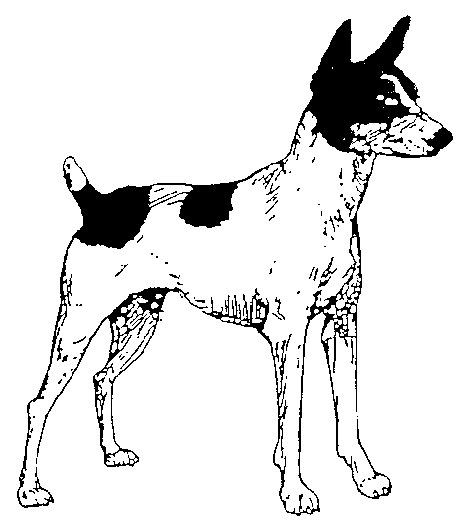Breed standards
Tenterfield Terrier
Breed standards are the official guidelines that describe the ideal characteristics, temperament, and appearance of a breed and ensures that the breed is fit for function with soundness essential.

Country of Origin: Australia
The Tenterfield Terrier is a strong, active, agile working terrier of great versatility and of pleasing proportion. The measurement of wither to ground and wither to rear point of buttock should be of equal proportions. The length of the head and neck should always be in balance to the whole of the dog. The coat is always smooth.
A keen, intelligent and alert expression which is denoted by the carriage of the ears and erect tail.
Confident, with an eagerness to learn, showing great loyalty to its owner and although fearless and bold at work, he is an ideal companion dog in the home.
Medium sized head in proportion to body. The head is only slightly rounded from ear to ear. Domed or apple heads are highly undesirable. When viewed from the front and side, head is to be wedge shaped and well filled in under the eyes. The stop to be moderate and when measured from that point to occiput it equals the distance from the stop to the tip of the nose with parallel planes. The colour of the nose is preferably black, with the exception of liver or blue which will have a self-coloured nose. There should be strength in the muzzle.
Not large, protruding or round, but slightly oval in shape. Dark preferred but may bear some relation to coat colour, with pigmented eye rims and a keen expression. Wall eyes are to be discouraged.
V shaped with slightly rounded tips, set high on the outer edge of the skull, erect or semi-erect. If semi-erect the top third of the ear tips forward. Not wide or large at the base, rather medium in size. The length of the ear to be roughly equal to the width between the ears. The ears are of a thin texture (not thick).
Strong jaws with full dentition and complete scissor bite, i.e. upper teeth closely overlapping the lower teeth. Lips to be tight fitting and pigmented. A wry mouth should be heavily penalised.
Strong and clean of moderate length, allowing head to be carried proudly.
Shoulders well sloped back and not too heavily muscled. Forelegs are of strong round bone in keeping with the size of the dog, straight when viewed from any angle with sufficient length of the upper arm which is well angled to the scapula ensuring the elbows are set under the body with the sternum clearly in front of the shoulder blades.
A short, compact, level topline. A strong back without slackness and with powerful loins. Ribs moderately sprung, back ribs deep and reaching well back with only a slight tuck up. The chest is of moderate width and reaching in depth to the level of the elbow, but not below.
Not too heavily muscled. The rump is well rounded with only a slight slope to the croup. Long and powerful thighs. The stifle is well bent and the hocks well let down. The pastern should be parallel when viewed from the rear, and vertical when viewed from the side.
Compact, round shaped, toes moderately arched.
Traditionally Docked.
Undocked: Tails can be of varying lengths. Bob tails often occur.
High set and erect when alert. Carried gaily, showing bold temperament.
Fore and hind legs carried straight forward and parallel. The elbows to move perpendicular to the body, working clear of the sides, stifles neither turning in nor out and the hocks not close, with good rear drive coming from the well flexing hindquarters.
To be short and of smooth texture. The Tenterfield Terrier is a single coated dog.
Predominantly white coat with black, tan, blue or liver markings of any shade. Tri colouring is common (i.e., white with black or white with blue or white with liver markings and tan cheeks and/or tan above eyes and/or tan breeches).
Brindle markings acceptable but not preferred. Full colour coats are not acceptable. Skin should always be pigmented.
The height to be 25.5 to 30.5cms (10 to 12 ins) with ideal being 28cms (11 ins) but not exceeding 30.5cms (12 ins). The weight to be in proportion to the size of the dog.
Any departure from the foregoing points should be considered a fault and the seriousness with which the fault should be regarded should be in exact proportion to its degree and its effect upon the health and welfare of the dog. Any weakness in the following should be particularly penalised.
Males animals should have two apparently normal testicles fully descended into the scrotum.



